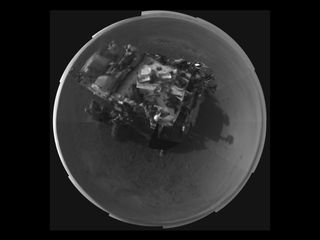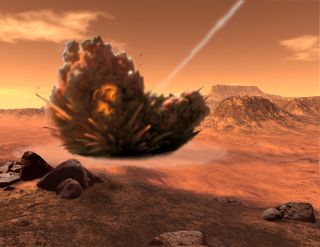
Search for Life Will Shape Future Mars Missions

PASADENA, Calif. — As NASA’s Curiosity rover prepares to get its wheels in motion on Mars, the space agency is set to issue a new look at where exploration of the Red Planet could go in the years and decades to come – based on the theme "Seeking the Signs of Life."
The report, stemming from a Concepts and Approaches for Mars Exploration meeting in Houston in June, is headed for a late August/September release. Former veteran NASA program manager Orlando Figueroa has been leading the appraisal under the wing of a newly established Mars Program Planning Group (MPPG), which was tasked with reformulating the agency’s Mars Exploration Program.

The planning group is taking a look at how NASA will continue exploring Mars beyond the missions currently operating today, which now includes the Curiosity rover. The $2.5 billion Mars rover Curiosity landed on the Red Planet on Aug. 5 (PDT) in a flawless touchdown. The flagship rover, which is already beaming home amazing photos of Mars, is expected to spend two years exploring Mars' Gale Crater to determine if the region could have ever supported microbial life.
Recently, deep cuts in NASA's budget for Mars led to the shakeup in the space agency’s plans for robotic exploration. Another factor behind the new report is the overlapping requirements of NASA’s long-range plan to dot the Red Planet with human footprints.
Deep budget cuts, new tech
Mars planners are assessing international partnerships that could be highly enabling, especially as exploration activities become increasingly complex. Such partnerships could be at the mission or instrument level, and they could involve scientists from around the globe. [Boldest Mars Missions in History]
The June get-together of Mars experts made a strong case that missions flown in the coming decade could yield realistic steps toward Mars Sample Return. That pathway also would push advances in our understanding of Mars and certify key technologies that can lead to a humans-to-Mars initiative.
Get the Space.com Newsletter
Breaking space news, the latest updates on rocket launches, skywatching events and more!
For example, work is under way to develop inflatable heat shields and larger parachutes.
“These will be tested in a program about a year from now,” said Charles Elachi, director of the Jet Propulsion Laboratory here.
“You’ll see that in this Mars Program Planning Group output,” said John Grunsfeld, associate administrator for the Science Mission Directorate.
“They are looking at mixing technology with increasing capability over time … leading up to putting larger things on the surface,” Grunsfeld said. Adopting those technologies would help put objects even larger than the 1-ton Curiosity rover on Mars, he told SPACE.com.
Less expensive Mars probes are also on NASA’s agenda.
And there’s no lack of ideas. Gliders and balloons, ground-thumping penetrators, deep drilling platforms, slinky robot snakes, and even sensor-laden tumbleweed-like vehicles are on the table. Toss into the mix an assortment of Mars orbiters to perform a variety of tasks, such as sniffing out traces of biologically produced methane.

No gimmicks on Mars
“It can’t just be a gimmicky thing,” Doug McCuistion, director of the NASA Mars Exploration Program, told SPACE.com. “This is — and needs to remain — a scientifically driven program. So anything that comes out of Orlando’s Mars Program Planning Group I will expect to be scientifically and technologically viable and useful.”
McCuistion said the group is to provide pathways or portfolios with mission and technology options that can be adjusted, manipulated and sequenced differently based on programmatic factors as well as budgetary factors.
“So I’m expecting it to provide us some flexibility for planning. Lots of options, lots of ideas, lots of possibilities … all of which have feasibility that we can use to build the next portfolio set,” McCuistion said.

Seeking the signs of life
The goal is to establish a plan with a 20-year horizon, McCuistion added.
“We’re thinking into the early 2030s … partly because President Obama’s challenge was humans in the area of Mars in 2033. So we’re kind of using that as an anchor point to plan backwards from.
“The entire Mars science community is at that point of taking that next step,” McCuistion said. “The Mars Science Laboratory transitions us from 'Follow the water' to seeking the signs of life … so that’s where we are headed.”
Leonard David has been reporting on the space industry for more than five decades. He is a winner of last year's National Space Club Press Award and a past editor-in-chief of the National Space Society's Ad Astra and Space World magazines. He has written for SPACE.com since 1999.
Join our Space Forums to keep talking space on the latest missions, night sky and more! And if you have a news tip, correction or comment, let us know at: community@space.com.

Leonard David is an award-winning space journalist who has been reporting on space activities for more than 50 years. Currently writing as Space.com's Space Insider Columnist among his other projects, Leonard has authored numerous books on space exploration, Mars missions and more, with his latest being "Moon Rush: The New Space Race" published in 2019 by National Geographic. He also wrote "Mars: Our Future on the Red Planet" released in 2016 by National Geographic. Leonard has served as a correspondent for SpaceNews, Scientific American and Aerospace America for the AIAA. He was received many awards, including the first Ordway Award for Sustained Excellence in Spaceflight History in 2015 at the AAS Wernher von Braun Memorial Symposium. You can find out Leonard's latest project at his website and on Twitter.
